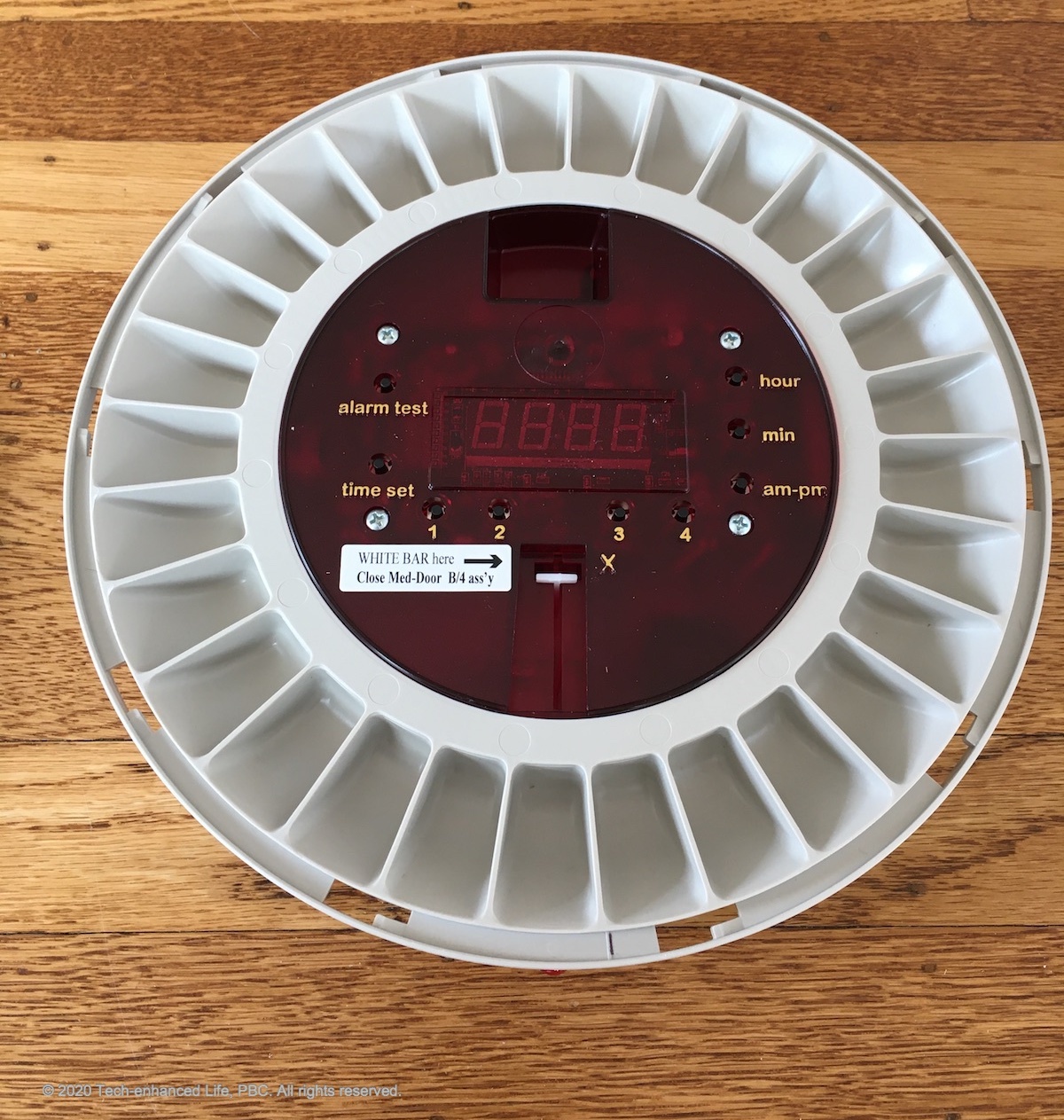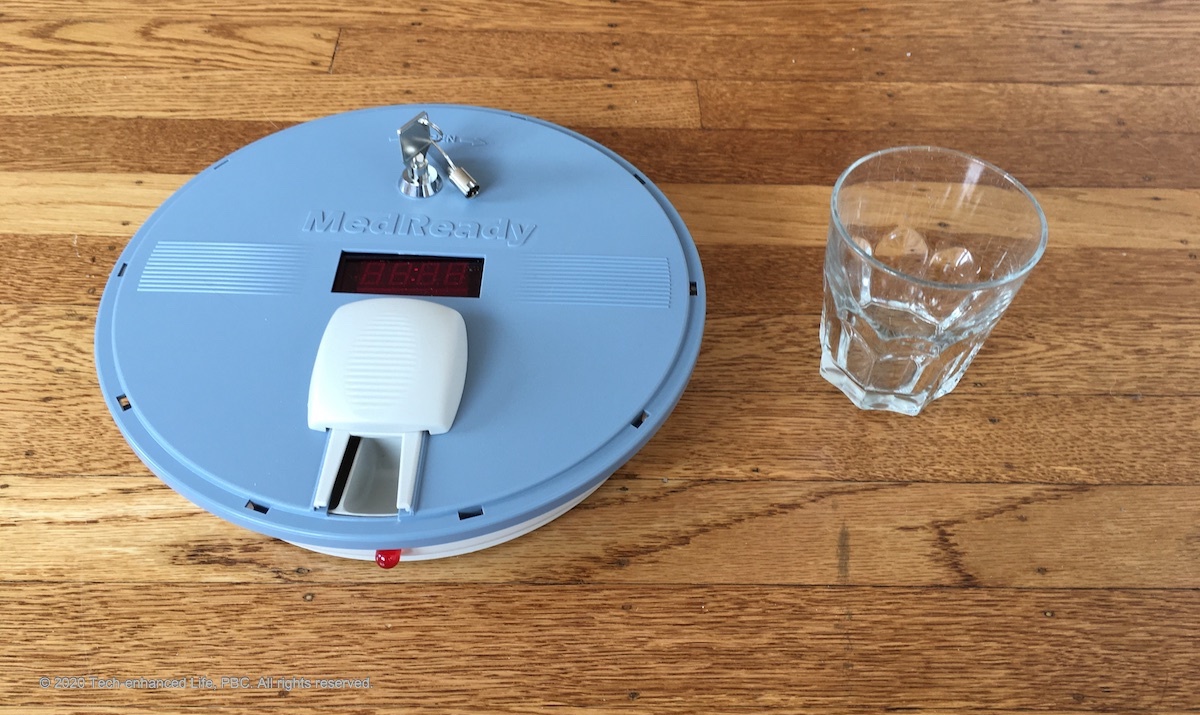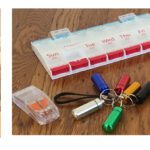MedReady Medication Dispenser : Review
By: Editorial Team | Posted: January 26, 2020 | Updated: May 8, 2025
The Basics
- Product: MR-357FL
- Company: MedReady
- Review Date: Q1 2020
Where to buy it or learn more*:
Discount for Tech-enhanced Life readers:
- Discount code:
- Discount amount:
Analyst Summary: MedReady | MR-357FL
The MedReady Medication Dispenser is designed to help you improve your adherence to the medication regimen prescribed by your healthcare providers. It does that by helping to organize your medication; and remind you which pills to take and when to take them.
This product was included in a comparative analysis of the entire class of automatic pill dispensers. If you are not sure yet whether this product is the one you need, that comparative evaluation should help you understand which pill dispenser will work best for your life situation.
This product is less expensive, and has less features, than many of the products we reviewed in that work. It does NOT handle the organizing of the pills (the “filling”) for you. You need to do that yourself. And it is limited to 28 “pill compartments”, which means one week of 4 doses per day for example.
The use case that makes the most sense for this product is when one person has the job of “filling” a person’s pill containers, and the person who needs those pills (the Dispensee) needs to be prevented from changing the medication, or taking the wrong medication at the wrong time. And when the medication regimen is fairly simple, and relatively unchanging.
The MedReady comes in several variants. We evaluated the MR-357FL, which has a built-in cellular modem to connect with a portal and help send notifications. There are less expensive variants without the connectivity.
Which Medications Can It Handle?
This product can handle any “pills”. It is not suitable for liquids or medication that needs refrigeration, nor does it include ways to remind you of these medications “outside” the dispenser.
User Interface (UI)
One of the common scenarios in which these types of products will be used involve two different people. One, which we call the “dispensee”, is the person who consumes the medication, and who needs to interface with the machine when it is time for the medications to be dispensed.
The second, which we call the “filler”, is the person who worries about putting the right medication into the system every week or month, and who sets up the “dispensing schedule” according to whatever schedule has been prescribed by the physicians of the dispensee.
In many scenarios, the filler will be a caregiver, or spouse, or adult child of the dispensee. However there will also be situations in which the dispensee also performs the job of the filler (i.e. when you worry about your own medication management instead of involving someone else).
This product operates rather like a conventional pill box, except that it is circular, and the Dispensee can not open the individual pill compartments. The compartments inside the system rotate, so that the appropriate pills are always under the “dispensing slot”.
When it is time for a “dose” it attracts your attention with flahing lights and (rather loud) noise. To “get the pills” you slide back a cover, and take the pills for that dose from the dispensing compartment.
Programming Medication Schedule
The first step in using this product after setting it up is to set up “alarms” that govern how often the product will dispense pills. You can set up to four alarm times per day, and you can do this either with buttons on the pill dispenser itself or via the web “Portal”.
When each alarm goes off, the pill box internal mechanism rotates and allows the next “pill group” to be accessed.
Once you have set the alarms, you need to put the appropriate pill groups into the correct slots in the machine.
Limits on Complexity of Regimen
You can have up to four “dose times” per day, and at each dose time you can have multiple pills, governed by the size of each pill container compartment. See “Capacity” below.
Filling (Putting Pills into the Device)
In our opinion, how well the product handles the “filling” step is a key differentiator between various pill dispenser systems and smart pill boxes. This product works just like a conventional pill box as far as filling is concerned.
How Filling Happens
You use a key to “unlock” the lid to the product, which lifts up and exposes a wheel of pill compartments. You manually place the appropriate pills for each dose into the different compartments. Getting the right pill in the right place is entirely up to whoever has the role of “filler”.
For straightforward medication regimens, this is not so complicated. For regimens where each dose needs different groups of pills, we think it would be easy to make a mistake with this type of product (no more so with this product than with conventional pill boxes, of course).

Caption: Medready Pill Dispenser being filled.
Capacity
The product has 28 pill compartments, and so could handle one dose per day for a month, four per day for a week and so on. It can handle as many as 4 alarms per day. Each “compartment” can take up to 12 of the “standard” pills (1) we used to compare capacity in our evaluation.
| Product | Doses /day | Pill “compartments” | Standard Pills / compartment | Total pill capacity |
|---|---|---|---|---|
| MedReady | 4 | 28 | 12 | 336 |
See Automatic Pill Dispensers: Hands-on Evaluations for a chart with “capacity” comparisons between this and the competing products.
Medication Database, Scanner
This product does not have these features.
Early / Late / Missed Doses / Flexibility
If you “miss” a dose, or need to take doses out prior to the correct dose time, the options are a bit limited. If you have the Caregiver “key”, you can easily open up the compartments and take pills out manually. You can use the portal to trigger an “early dose”.
Separation between Dispensee and Filler Roles
One of the key “features” of this product, compared to a conventional pill box, is that the “Dispensee” can not get into the pill box to adjust medication, or to take any medication other than that appropriate for the specific dose time. So for situations where a clean separation is needed between Dispensee and Filler roles, this product does a good job of accomplishing that.
Physical & Cognitive Impairments
For someone with reasonably good cognition, and no huge physical impairments, we thought this product was very easy to use. But we question the benefit over a conventional pill box for that person.
This product appears to be specifically designed for situations in which people with impaired cognition need a way to take their medications (with someone else doing the “filling”).
For people with tremor, poor eyesight, or severe arthritis, we did not see any especial problems.
NOTE: This product had by far the loudest Buzzer / Beeper to alert you that your dose is due of any of the products we evaluated.
“Time to Refill”
There are no clever features to help remember to refill.
Set Up & Connectivity
Connectivity
This product connects to the Internet using a built in cellular modem. Setting it up was straightforward.
The system can work with either the AT&T or the Verizon network (in both cases the 4G network), which means it should work anywhere one or other of those carriers have good service. You specify which carrier you need when you purchase the product.
There is a less expensive version of the product that has no Internet connectivity, and thus cannot do caregiver notifications. We did not evaluate that version.
General Setup
Setting the system up for the first time requires turning it on, and logging into the “portal” and setting the alarm times, or setting up the alarms manually using buttons on the product. As “setup” routines go, it seemed fairly straightforward.
Portal or App
The Portal allows you to set or change the four “alarms”, and adjust various device settings like audio and visual alerts, vacation mode, and various test settings. And you can see a “log” which records when various doses were taken.
You can also set up notifications via email, sms, or automated phone calls for situations in which the dose was not taken, and can get daily/weekly compliance reports emailed to individuals you designate.
Remote medication adjustment
You cannot make any changes remotely, except to adjust the “times” of the alarms (and thus the times at which each compartment opens), which you can do via the portal.
Caregiver Monitoring
The product clearly has in mind the scenario of a caregiver or family member who is involved in helping to manage the medications of someone else (an older adult for example).
The portal can send notifications if the dispensee has not taken medication at the right time.
Additional Features & Details
Security & Anti-tampering
Dispensee with Cognitive Impairment
The pill compartments in the system itself are locked by a key. Adjusting medication schedules (the alarms) happens via the Portal, which can be limited to Caregivers if that is appropriate.
“Others” Using your Meds
There is a separate situation which some of the products in this category worry about. That is the situation in which the wrong person takes “your” pills. A topical example is in the case of opioids, for example, where you do not want others with access to the house to be able to take “your” opioids. As best we can see, this product does NOT address this situation.
Hacking the System
Because it is connected to the Internet, it is theoretically possible someone could hack into and gain control of the system. In our opinion, anything connected to the Internet is potentially hackable, and we would bet this product is no exception. It’s like the decision to use a phone or a computer, or Alexa, or any other piece of useful technology. You make a decision whether the risk of being hacked does or does not outweigh the potential benefits. In this case the potential benefits are significant.
Power & Battery Backup
The system connects to a power outlet. It has a built in battery backup which the company says lasts for 48 hours.
Vacations & Trips & Leaving the House
The relatively small size of this product is a big advantage. It would be fairly easy to pack this in your carry-on or suitcase and take it with you. However it is quite a bit larger than the GMS pill dispenser, to which it is a head to head competitor, and which was our preferred recommendation in Automatic Pill Dispensers: Hands-on Evaluation.
Aesthetics
The overall look and feel of the product is, we are sorry to say, rather ugly. Something about the color and look and feel were distinctly off putting to our team, and the numerous older adults we showed it to.
It is a disc like a flying saucer, with diameter about eleven inches and height about 2 inches.
Pricing
In Q1 2020 on Amazon the product we evaluated (MR-357FL) listed for $307 . The simpler (no connectivity MR 1700FL) listed for $159.
Manual, Support, Training
There is some (paper) “setup documentation”. It seemed adequate, and mentions some videos on a website for extra tips.
Languages: Documentation and the interface seem to only come in “English”.
References
(1) The pill we chose as a standard was on the larger side actually. It was oblong in shape and roughly 17mm long by 7mm wide. So, to avoid confusion, this is not “standard” in any widely acknowledged sense. It is just what we chose to use.
Where to buy it or learn more*: (this takes you away from our website)

Discount for Tech-enhanced Life readers:
- Discount code:
- Discount amount:
*Disclosure: The research and opinions in this article are those of the author, and may or may not reflect the official views of Tech-enhanced Life.
If you use the links on this website when you buy products we write about, we may earn commissions from qualifying purchases as an Amazon Associate or other affiliate program participant. This does not affect the price you pay. We use the (modest) income to help fund our research.
In some cases, when we evaluate products and services, we ask the vendor to loan us the products we review (so we don’t need to buy them). Beyond the above, Tech-enhanced Life has no financial interest in any products or services discussed here, and this article is not sponsored by the vendor or any third party. See How we Fund our Work.

Consider updating. MedReady
Consider updating. MedReady MR357FS is lockable whereas the GMS(?) is not?